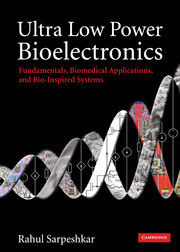Book contents
- Frontmatter
- Contents
- Acknowledgements
- Section I Foundations
- 1 The big picture
- 2 Feedback systems: fundamentals, benefits, and root-locus analysis
- 3 MOS device physics: general treatment
- 4 MOS device physics: practical treatment
- 5 MOS device physics: small-signal operation
- 6 Deep submicron effects in MOS transistors
- 7 Noise in devices
- 8 Noise in electrical and non-electrical circuits
- 9 Feedback systems
- 10 Return-ratio analysis
- Section II Low-power analog and biomedical circuits
- Section III Low-power RF and energy-harvesting circuits for biomedical systems
- Section IV Biomedical electronic systems
- Section V Principles for ultra-low-power analog and digital design
- Section VI Bio-inspired systems
- Section VII Energy sources
- Bibliography
- Index
- Epilogue
- References
6 - Deep submicron effects in MOS transistors
from Section I - Foundations
Published online by Cambridge University Press: 02 December 2010
- Frontmatter
- Contents
- Acknowledgements
- Section I Foundations
- 1 The big picture
- 2 Feedback systems: fundamentals, benefits, and root-locus analysis
- 3 MOS device physics: general treatment
- 4 MOS device physics: practical treatment
- 5 MOS device physics: small-signal operation
- 6 Deep submicron effects in MOS transistors
- 7 Noise in devices
- 8 Noise in electrical and non-electrical circuits
- 9 Feedback systems
- 10 Return-ratio analysis
- Section II Low-power analog and biomedical circuits
- Section III Low-power RF and energy-harvesting circuits for biomedical systems
- Section IV Biomedical electronic systems
- Section V Principles for ultra-low-power analog and digital design
- Section VI Bio-inspired systems
- Section VII Energy sources
- Bibliography
- Index
- Epilogue
- References
Summary
It [Moore's law] can't continue forever. The nature of exponentials is that you push them out and eventually disaster happens.
Gordon Moore, 2005In this chapter, we discuss how to model effects that arise in transistors with short channel lengths. Such short-channel transistors have correspondingly thin gate oxides, shallow source/drain junctions, high doping, and small operational supply and threshold voltages. The models are accurate for transistor lengths that range from 1 μm to 0.01 μm (10 nm), where semi-classical approximations of transistor function are still valid. We shall allude to some quantum phenomena as well. We shall begin by first describing the EKV model in a long-channel transistor. The EKV model is an insightful charge-based model that captures subthreshold and above-threshold operation in a simple analytic fashion. It is named after its originators, Enz, Krummenacher, and Vittoz. Then, based on a short-channel model in [2], we shall modify the long-channel EKV model to describe a short-channel effect that is important in above-threshold operation, namely velocity saturation. As the lateral electric field in a transistor increases with increasing drain-to-source voltage, the drift velocity of electrons in short-channel transistors begins to saturate and limit at a maximum velocity vsat; the drift velocity is then no longer related to the lateral electric field via the mobility proportionality constant as it is in long-channel transistors.
- Type
- Chapter
- Information
- Ultra Low Power BioelectronicsFundamentals, Biomedical Applications, and Bio-Inspired Systems, pp. 129 - 154Publisher: Cambridge University PressPrint publication year: 2010



